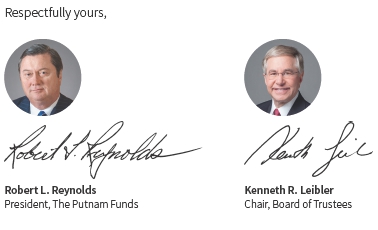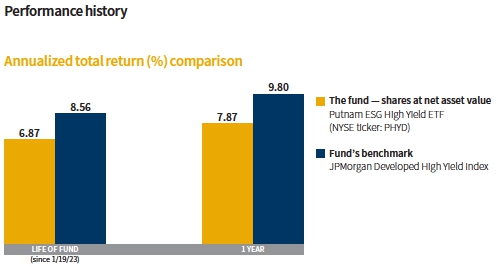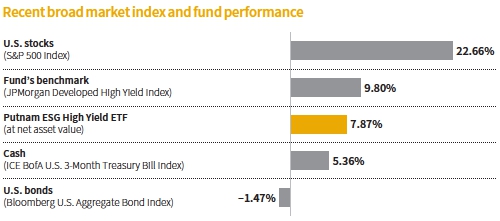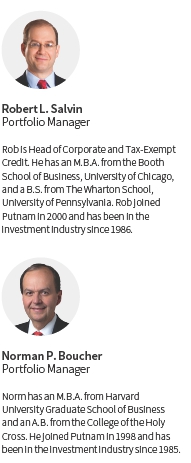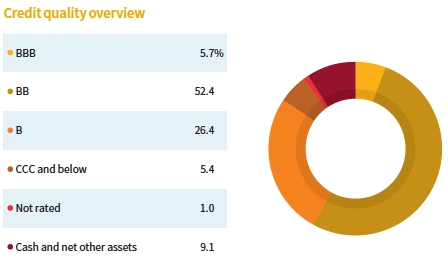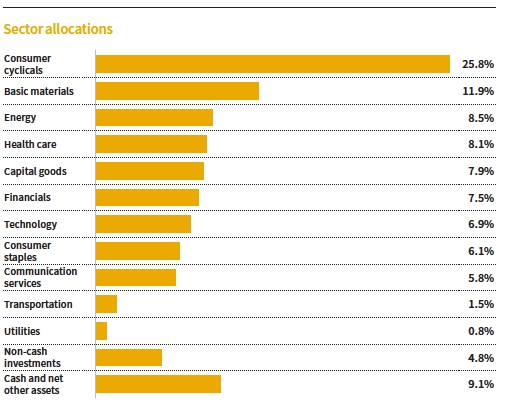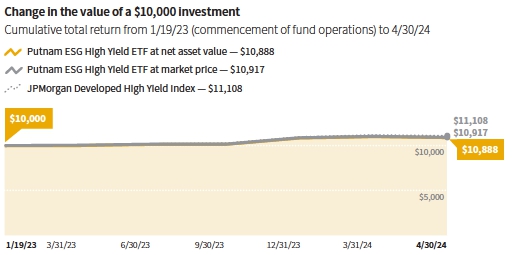ASC 820 establishes a three-level hierarchy for disclosure of fair value measurements. The valuation hierarchy is based upon the transparency of inputs to the valuation of the fund’s investments. The three levels are defined as follows:
Level 1: Valuations based on quoted prices for identical securities in active markets.
Level 2: Valuations based on quoted prices in markets that are not active or for which all significant inputs are observable, either directly or indirectly.
Level 3: Valuations based on inputs that are unobservable and significant to the fair value measurement.
The following is a summary of the inputs used to value the fund’s net assets as of the close of the reporting period:
| | | |
| | Valuation inputs |
| Investments in securities: | Level 1 | Level 2 | Level 3 |
| Convertible bonds and notes | $— | $1,053,145 | $— |
| Convertible preferred stocks | — | 343,930 | — |
| Corporate bonds and notes | — | 103,661,664 | — |
| Senior loans | — | 8,693,799 | — |
| Short-term investments | 12,229,418 | — | — |
| Totals by level | $12,229,418 | $113,752,538 | $— |
|
| | | |
| | Valuation inputs |
| Other financial instruments: | Level 1 | Level 2 | Level 3 |
| Credit default contracts | $— | $358,678 | $— |
| Totals by level | $— | $358,678 | $— |
The accompanying notes are an integral part of these financial statements.
Statement of assets and liabilities 4/30/24
| |
| ASSETS | |
| Investment in securities, at value (Note 1): | |
| Unaffiliated issuers (identified cost $113,517,060) | $113,752,538 |
| Affiliated issuers (identified cost $12,229,418) (Note 6) | 12,229,418 |
| Cash | 146,055 |
| Interest and other receivables | 1,987,373 |
| Receivable for investments sold | 287,266 |
| Deposits with broker (Note 1) | 475,057 |
| Total assets | 128,877,707 |
| |
| LIABILITIES | |
| Payable for investments purchased | 1,405,718 |
| Payable for compensation of Manager (Note 2) | 106,141 |
| Payable for variation margin on centrally cleared swap contracts (Note 1) | 29,201 |
| Payable to broker (Note 1) | 2,339 |
| Total liabilities | 1,543,399 |
| | |
| Net assets | $127,334,308 |
| |
| REPRESENTED BY | |
| Paid-in capital (Unlimited shares authorized) (Notes 1, 4 and 5) | $127,282,191 |
| Total distributable earnings (Note 1) | 52,117 |
| Total — Representing net assets applicable to capital shares outstanding | $127,334,308 |
| |
| COMPUTATION OF NET ASSET VALUE | |
| Net asset value per share | |
| ($127,334,308 divided by 2,550,000 shares) | $49.94 |
The accompanying notes are an integral part of these financial statements.
Statement of operations Year ended 4/30/24
| |
| INVESTMENT INCOME | |
| Interest (including interest income of $356,689 from investments in affiliated issuers) (Note 6) | $8,172,664 |
| Dividends | 29,367 |
| Total investment income | 8,202,031 |
| |
| EXPENSES | |
| Compensation of Manager (Note 2) | 604,513 |
| Fees waived and reimbursed by Manager (Note 2) | (19,690) |
| Total expenses | 584,823 |
| | |
| Net investment income | 7,617,208 |
| |
| REALIZED AND UNREALIZED GAIN (LOSS) | |
| Net realized gain (loss) on: | |
| Securities from unaffiliated issuers (Notes 1 and 3) | (169,676) |
| Swap contracts (Note 1) | 394,125 |
| Total net realized gain | 224,449 |
| Change in net unrealized appreciation (depreciation) on: | |
| Securities from unaffiliated issuers | 201,413 |
| Swap contracts | (83,336) |
| Total change in net unrealized appreciation | 118,077 |
| | |
| Net gain on investments | 342,526 |
| |
| Net increase in net assets resulting from operations | $7,959,734 |
The accompanying notes are an integral part of these financial statements.
Statement of changes in net assets
| | |
| | | For the period |
| | | 1/19/23 |
| | | (commencement |
| | | of operations) |
| INCREASE IN NET ASSETS | Year ended 4/30/24 | to 4/30/23 |
| Operations | | |
| Net investment income | $7,617,208 | $1,614,010 |
| Net realized gain (loss) on investments | 224,449 | (486,345) |
| Change in net unrealized appreciation of investments | 118,077 | 85,602 |
| Net increase in net assets resulting from operations | 7,959,734 | 1,213,267 |
| Distributions to shareholders (Note 1): | | |
| From ordinary income | | |
| Net investment income | (8,253,931) | (1,112,200) |
| From return of capital | (38,853) | — |
| Proceeds from shares sold (Note 4) | 22,733,979 | 104,197,419 |
| Decrease from shares redeemed (Note 4) | — | (24,562,209) |
| Other capital (Note 4) | 90,936 | 106,166 |
| Total increase in net assets | 22,491,865 | 79,842,443 |
| |
| NET ASSETS | | |
| Beginning of period (Note 5) | 104,842,443 | 25,000,000 |
| End of period | $127,334,308 | $104,842,443 |
| |
| NUMBER OF FUND SHARES | | |
| Shares outstanding at beginning of period (Note 5) | 2,100,000 | 500,000 |
| Shares sold (Note 4) | 450,000 | 2,100,000 |
| Shares redeemed (Note 4) | — | (500,000) |
| Shares outstanding at end of period | 2,550,000 | 2,100,000 |
The accompanying notes are an integral part of these financial statements.
Financial highlights
(For a common share outstanding throughout the period)
| | |
| PER-SHARE OPERATING PERFORMANCE | | |
| | | For the period |
| | | 1/19/23 |
| | | (commencement |
| | Year ended | of operations) |
| | 4/30/24 | to 4/30/23 |
| Net asset value, beginning of period | $49.92 | $50.00 |
| Investment operations: | | |
| Net investment income (loss) a | 3.45 | .93 |
| Net realized and unrealized gain (loss) on investments | .29 | (.53) |
| Total from investment operations | 3.74 | .40 |
| Less distributions: | | |
| From net investment income | (3.74) | (.54) |
| From return of capital | (.02) | — |
| Total distributions | (3.76) | (.54) |
| Other capital | .04 | .06 |
| Net asset value, end of period | $49.94 | $49.92 |
| Total return at net asset value (%) b | 7.87 | 0.93* |
| |
| RATIOS AND SUPPLEMENTAL DATA | | |
| Net assets, end of period (in thousands) | $127,334 | $104,842 |
| Ratio of expenses to average net assets (%) c,d | .53 | .15* |
| Ratio of net investment income (loss) to average net assets (%) d | 6.93 | 1.88* |
| Portfolio turnover (%) e | 47 | 10* |
* Not annualized.
a Per share net investment income (loss) has been determined on the basis of the weighted average number of shares outstanding during the period.
b Total return assumes dividend reinvestment.
c Excludes acquired fund fees and expenses, if any.
d Reflects waivers of certain fund expenses in connection with investments in Putnam Government Money Market Fund during the period (Note 2). As a result of such waivers, the expenses of the fund reflect a reduction of the following amounts:
| |
| | Percentage of average net assets |
| April 30, 2024 | 0.02% |
| April 30, 2023 | less than 0.01% |
e Portfolio turnover excludes securities received or delivered in-kind.
The accompanying notes are an integral part of these financial statements.
Notes to financial statements 4/30/24
Unless otherwise noted, the “reporting period” represents the period from May 1, 2023 through April 30, 2024. The following table defines commonly used references within the Notes to financial statements:
| |
| References to | Represent |
| ESG | Environmental, social and/or corporate governance |
| ETF | Exchange-traded fund |
| Franklin Templeton | Franklin Resources, Inc. |
| JPMorgan | JPMorgan Chase Bank, N.A. |
| OTC | Over-the-counter |
| PIL | Putnam Investments Limited, an affiliate of Putnam Management |
| Putnam Management | Putnam Investment Management, LLC, the fund’s manager, an indirect wholly-owned |
| | subsidiary of Franklin Templeton |
| SEC | Securities and Exchange Commission |
| State Street | State Street Bank and Trust Company |
Putnam ESG High Yield ETF (the fund) is a diversified, open-end series of Putnam ETF Trust (the Trust), a Delaware statutory trust organized under the Investment Company Act of 1940, as amended. The fund is an actively managed ETF. The fund’s investment objective is to seek high current income. Capital growth is a secondary goal when consistent with achieving high current income.
The fund invests mainly in bonds that are below investment grade in quality (sometimes referred to as “junk bonds”) with a focus on companies or issuers that Putnam Investment Management, LLC (“Putnam Management”), the fund’s investment manager, believes meet relevant environmental, social or governance (“ESG”) criteria on a sector-specific basis (“ESG criteria”). The fund invests mainly in bonds that also have one or more of the following characteristics: (1) are obligations of U.S. companies or issuers and (2) have intermediate- to long-term maturities (three years or longer). The fund invests with a focus on companies or issuers that Putnam Management believes meet relevant environmental, social or governance (“ESG”) criteria on a sector-specific basis (“ESG criteria”). The fund may consider, among other factors, a company’s or issuer’s ESG criteria (as described below), credit, interest rate, liquidity and prepayment risks, as well as general market conditions, when deciding whether to buy or sell investments.
Under normal circumstances, the fund invests at least 80% of the value of its net assets in fixed-income securities rated below investment grade that meet Putnam Management’s ESG criteria. This policy is non-fundamental and may be changed only after 60 days’ notice to shareholders. Putnam Management may not apply ESG criteria to investments that are not subject to the fund’s 80% policy and such investments may not meet Putnam Management’s ESG criteria.
In evaluating investments for the fund, Putnam Management identifies relevant ESG criteria on a sector-specific basis using an internally developed materiality map, which is informed by the ESG issues identified by the Sustainability Accounting Standards Board as material to companies or issuers within a particular industry. A materiality map provides a guide to understanding which ESG criteria are more or less important for a given sector or subsector; it includes those ESG criteria that may be reasonably likely to influence investment decision-making. Putnam Management constructs the materiality map by evaluating the significance of specified ESG criteria (i.e., board structure and composition, diversity, equity and inclusion, or climate change risk, among others) in specific industries (i.e., consumer, healthcare, financials, etc.), subsectors, or countries. Putnam Management then categorizes the relevance of each ESG criteria for each industry, subsector, or country. As part of this analysis, Putnam Management may utilize metrics and information such as emissions data, carbon intensity, sources of energy used for operations, water use and re-use, water generation, waste diversion from landfill, employee safety and diversity data, supplier audits, product safety, board composition, and incentive compensation structures. After evaluating these criteria, Putnam Management will assign each company or issuer, as applicable, a proprietary ESG rating ranging from 1 to 4 (1 indicating the highest (best) ESG rating and 4 indicating the lowest (worst) ESG rating). In order to meet Putnam Management’s ESG criteria for purposes of the above-referenced non-fundamental investment policy, a company or issuer must be rated 2 or 1 by Putnam Management. While Putnam Management may consider independent third-party data as a part of its analytical process, the portfolio management team performs its own independent analysis of issuers and does not rely solely on third-party screens.
The fund’s approach to ESG investing incorporates fundamental research together with consideration of ESG criteria which may include, but are not limited to, those included in the following descriptions. Environmental criteria include, for example, a company’s or issuer’s carbon intensity and use of resources like water or minerals. ESG measures in this area might include plans to reduce waste, increase recycling, raise the proportion of energy supply from renewable sources, or improve product design to be less resource intensive. Social criteria include, for example, labor practices and supply chain management. ESG measures in this area might include programs to improve employee well-being, commitment to workplace equality and diversity, or improved stewardship of supplier relationships and working conditions. Corporate governance criteria include, for example, board composition and executive compensation, as well as bondholders’ rights. ESG measures in this area might include improvements in board independence or diversity, or alignment of management incentives with the company’s or issuer’s strategic ESG objectives.
Putnam Management uses a sector-specific approach in evaluating investments. In the corporate credit sector, Putnam Management combines fundamental analysis with relevant ESG insights with a forward-looking perspective. Putnam Management believes that this approach contributes to a more nuanced assessment of an issuer’s credit profile, which offers potential opportunity to limit tail risk in credit portfolios (i.e., the risk that the price of a portfolio may decrease by more than three standard deviations from its current price) and ratings volatility.
Putnam Management evaluates ESG considerations using independent third-party data (where available), and also uses company or issuer disclosures and public data sources. Putnam Management believes that ESG considerations are best analyzed in combination with a company’s or issuer’s fundamentals, including a company’s or issuer’s industry, location, strategic position, and key relationships.
In addition to bonds, the fund may also invest in other fixed-income instruments, including bank loans. In addition to the main investment strategies described above, the fund may make other types of investments, such as investments in equity securities, asset-backed, hybrid and structured bonds and notes, preferred securities that would be characterized as debt securities under applicable accounting standards and tax laws, and assignments of and participations in fixed and floating rate bank loans. The fund may also use derivatives, such as futures, options, certain foreign currency transactions and swap contracts, for both hedging and non-hedging purposes.
In the normal course of business, the fund enters into contracts that may include agreements to indemnify another party under given circumstances. The fund’s maximum exposure under these arrangements is unknown as this would involve future claims that may be, but have not yet been, made against the fund. However, the fund’s management team expects the risk of material loss to be remote.
The fund has entered into contractual arrangements with an investment adviser, administrator, distributor, transfer agent and custodian, who each provide services to the fund. Unless expressly stated otherwise, shareholders are not parties to, or intended beneficiaries of these contractual arrangements, and these contractual arrangements are not intended to create any shareholder right to enforce them against the service providers or to seek any remedy under them against the service providers, either directly or on behalf of the fund.
Under the Trust’s Agreement and Declaration of Trust, any claims asserted by a shareholder against or on behalf of the Trust (or its series), including claims against Trustees and Officers, must be brought in courts of the State of Delaware.
Note 1: Significant accounting policies
The fund follows the accounting and reporting guidance in Financial Accounting Standards Board (FASB) Accounting Standards Codification Topic 946, Financial Services – Investment Companies (ASC 946) and applies the specialized accounting and reporting guidance in U.S. Generally Accepted Accounting Principles (U.S. GAAP), including, but not limited to, ASC 946. The following is a summary of significant accounting policies consistently followed by the fund in the preparation of its financial statements. The preparation of financial statements is in conformity with accounting principles generally accepted in the United States of America and requires management to make estimates and assumptions that affect the reported amounts of assets and liabilities in the financial statements and the reported amounts of increases and decreases in net assets from operations. Actual results could differ from those estimates. Subsequent events after the Statement of assets and liabilities date through the date that the financial statements were issued have been evaluated in the preparation of the financial statements.
Security valuation Portfolio securities and other investments are valued using policies and procedures adopted by the Board of Trustees. The Trustees have formed a Pricing Committee to oversee the implementation of these procedures and have delegated responsibility for valuing the fund’s assets in accordance with these procedures
to Putnam Management. Putnam Management has established an internal Valuation Committee that is responsible for making fair value determinations, evaluating the effectiveness of the pricing policies of the fund and reporting to the Pricing Committee.
Investments for which market quotations are readily available are valued at the last reported sales price on their principal exchange, or official closing price for certain markets, and are classified as Level 1 securities under Accounting Standards Codification 820 Fair Value Measurements and Disclosures (ASC 820). If no sales are reported, as in the case of some securities that are traded OTC, a security is valued at its last reported bid price and is generally categorized as a Level 2 security.
Investments in open-end investment companies (excluding exchange-traded funds), if any, which can be classified as Level 1 or Level 2 securities, are valued based on their net asset value. The net asset value of such investment companies equals the total value of their assets less their liabilities and divided by the number of their outstanding shares.
Market quotations are not considered to be readily available for certain debt obligations (including short-term investments with remaining maturities of 60 days or less) and other investments; such investments are valued on the basis of valuations furnished by an independent pricing service approved by the Trustees or dealers selected by Putnam Management. Such services or dealers determine valuations for normal institutional-size trading units of such securities using methods based on market transactions for comparable securities and various relationships, generally recognized by institutional traders, between securities (which consider such factors as security prices, yields, maturities and ratings). These securities will generally be categorized as Level 2.
Many securities markets and exchanges outside the U.S. close prior to the scheduled close of the New York Stock Exchange and therefore the closing prices for securities in such markets or on such exchanges may not fully reflect events that occur after such close but before the scheduled close of the New York Stock Exchange. Accordingly, on certain days, the fund will fair value certain foreign equity securities taking into account multiple factors including movements in the U.S. securities markets, currency valuations and comparisons to the valuation of American Depository Receipts, exchange-traded funds and futures contracts. The foreign equity securities, which would generally be classified as Level 1 securities, will be transferred to Level 2 of the fair value hierarchy when they are valued at fair value. The number of days on which fair value prices will be used will depend on market activity and it is possible that fair value prices will be used by the fund to a significant extent. Securities quoted in foreign currencies, if any, are translated into U.S. dollars at the current exchange rate.
To the extent a pricing service or dealer is unable to value a security or provides a valuation that Putnam Management does not believe accurately reflects the security’s fair value, the security will be valued at fair value by Putnam Management, which has been designated as valuation designee pursuant to Rule 2a–5 under the Investment Company Act of 1940, in accordance with policies and procedures approved by the Trustees. Certain investments, including certain restricted and illiquid securities and derivatives, are also valued at fair value following procedures approved by the Trustees. These valuations consider such factors as significant market or specific security events such as interest rate or credit quality changes, various relationships with other securities, discount rates, U.S. Treasury, U.S. swap and credit yields, index levels, convexity exposures, recovery rates, sales and other multiples and resale restrictions. These securities are classified as Level 2 or as Level 3 depending on the priority of the significant inputs.
To assess the continuing appropriateness of fair valuations, the Valuation Committee reviews and affirms the reasonableness of such valuations on a regular basis after considering all relevant information that is reasonably available. Such valuations and procedures are reviewed periodically by the Trustees. The fair value of securities is generally determined as the amount that the fund could reasonably expect to realize from an orderly disposition of such securities over a reasonable period of time. By its nature, a fair value price is a good faith estimate of the value of a security in a current sale and does not reflect an actual market price, which may be different by a material amount.
Joint trading account Pursuant to an exemptive order from the SEC, the fund may transfer uninvested cash balances into a joint trading account along with the cash of other registered investment companies and certain other accounts managed by Putnam Management. These balances may be invested in issues of short-term investments having maturities of up to 90 days.
Repurchase agreements The fund, or any joint trading account, through its custodian, receives delivery of the underlying securities, the fair value of which at the time of purchase is required to be in an amount at least equal to the resale price, including accrued interest. Collateral for certain tri-party repurchase agreements, is held at the counterparty’s custodian in a segregated account for the benefit of the fund and the counterparty. Putnam
Management is responsible for determining that the value of these underlying securities is at all times at least equal to the resale price, including accrued interest. In the event of default or bankruptcy by the other party to the agreement, retention of the collateral may be subject to legal proceedings.
Security transactions and related investment income Security transactions are recorded on the trade date (the date the order to buy or sell is executed). Gains or losses on securities sold are determined on the identified cost basis.
Interest income, net of any applicable withholding taxes, if any, is recorded on the accrual basis. Amortization and accretion of premiums and discounts on debt securities, if any, is recorded on the accrual basis.
Dividend income, net of any applicable withholding taxes, is recognized on the ex-dividend date except that certain dividends from foreign securities, if any, are recognized as soon as the fund is informed of the ex-dividend date. Non-cash dividends, if any, are recorded at the fair value of the securities received. Dividends representing a return of capital or capital gains, if any, are reflected as a reduction of cost and/or as a realized gain.
The fund may have earned certain fees in connection with its senior loan purchasing activities. These fees, if any, are treated as market discount and are amortized into income in the Statement of operations.
Credit default contracts The fund entered into OTC and/or centrally cleared credit default contracts for hedging credit risk, for gaining liquid exposure to individual names and for hedging market risk.
In OTC and centrally cleared credit default contracts, the protection buyer typically makes a periodic stream of payments to a counterparty, the protection seller, in exchange for the right to receive a contingent payment upon the occurrence of a credit event on the reference obligation or all other equally ranked obligations of the reference entity. Credit events are contract specific but may include bankruptcy, failure to pay, restructuring and obligation acceleration. For OTC credit default contracts, an upfront payment received by the fund is recorded as a liability on the fund’s books. An upfront payment made by the fund is recorded as an asset on the fund’s books. Centrally cleared credit default contracts provide the same rights to the protection buyer and seller except the payments between parties, including upfront premiums, are settled through a central clearing agent through variation margin payments. Upfront and periodic payments received or paid by the fund for OTC and centrally cleared credit default contracts are recorded as realized gains or losses at the reset date or close of the contract. The OTC and centrally cleared credit default contracts are marked to market daily based upon quotations from an independent pricing service or market makers. Any change in value of OTC credit default contracts is recorded as an unrealized gain or loss. Daily fluctuations in the value of centrally cleared credit default contracts are recorded in variation margin on the Statement of assets and liabilities and recorded as unrealized gain or loss. Upon the occurrence of a credit event, the difference between the par value and fair value of the reference obligation, net of any proportional amount of the upfront payment, is recorded as a realized gain or loss.
In addition to bearing the risk that the credit event will occur, the fund could be exposed to market risk due to unfavorable changes in interest rates or in the price of the underlying security or index or the possibility that the fund may be unable to close out its position at the same time or at the same price as if it had purchased the underlying reference obligations. In certain circumstances, the fund may enter into offsetting OTC and centrally cleared credit default contracts which would mitigate its risk of loss. Risks of loss may exceed amounts recognized on the Statement of assets and liabilities. The fund’s maximum risk of loss from counterparty risk, either as the protection seller or as the protection buyer, is the fair value of the contract. This risk may be mitigated for OTC credit default contracts by having a master netting arrangement between the fund and the counterparty and for centrally cleared credit default contracts through the daily exchange of variation margin. Counterparty risk is further mitigated with respect to centrally cleared credit default swap contracts due to the clearinghouse guarantee fund and other resources that are available in the event of a clearing member default. Where the fund is a seller of protection, the maximum potential amount of future payments the fund may be required to make is equal to the notional amount.
OTC and centrally cleared credit default contracts outstanding, including their respective notional amounts at period end, if any, are listed after the fund’s portfolio.
At the close of the reporting period, the fund has deposited cash valued at $475,057 in a segregated account to cover margin requirements on open centrally cleared credit default contracts.
Master agreements The fund is a party to ISDA (International Swaps and Derivatives Association, Inc.) Master Agreements that govern OTC derivative and foreign exchange contracts and Master Securities Forward Transaction Agreements that govern transactions involving mortgage-backed and other asset-backed securities that may result in delayed delivery (Master Agreements) with certain counterparties entered into from time to time. The
Master Agreements may contain provisions regarding, among other things, the parties’ general obligations, representations, agreements, collateral requirements, events of default and early termination. With respect to certain counterparties, in accordance with the terms of the Master Agreements, collateral pledged to the fund is held in a segregated account by the fund’s custodian and, with respect to those amounts which can be sold or repledged, are presented in the fund’s portfolio.
Collateral pledged by the fund is segregated by the fund’s custodian and identified in the fund’s portfolio. Collateral can be in the form of cash or debt securities issued by the U.S. Government or related agencies or other securities as agreed to by the fund and the applicable counterparty. Collateral requirements are determined based on the fund’s net position with each counterparty.
With respect to ISDA Master Agreements, termination events applicable to the fund may occur upon a decline in the fund’s net assets below a specified threshold over a certain period of time. Termination events applicable to counterparties may occur upon a decline in the counterparty’s long-term or short-term credit ratings below a specified level. In each case, upon occurrence, the other party may elect to terminate early and cause settlement of all derivative and foreign exchange contracts outstanding, including the payment of any losses and costs resulting from such early termination, as reasonably determined by the terminating party. Any decision by one or more of the fund’s counterparties to elect early termination could impact the fund’s future derivative activity.
At the close of the reporting period, the fund did not have a net liability position on open derivative contracts subject to the Master Agreements.
Lines of credit The fund participates, along with other Putnam funds, in a $320 million syndicated unsecured committed line of credit, provided by State Street ($160 million) and JPMorgan ($160 million), and a $235.5 million unsecured uncommitted line of credit, provided by State Street. Borrowings may be made for temporary or emergency purposes, including the funding of shareholder redemption requests and trade settlements. Interest is charged to the fund based on the fund’s borrowing at a rate equal to 1.25% plus the higher of (1) the Federal Funds rate and (2) the Overnight Bank Funding Rate for the committed line of credit and 1.30% plus the higher of (1) the Federal Funds rate and (2) the Overnight Bank Funding Rate for the uncommitted line of credit. A closing fee equal to 0.04% of the committed line of credit and 0.04% of the uncommitted line of credit has been paid by the participating funds and a $75,000 fee has been paid by the participating funds to State Street as agent of the syndicated committed line of credit. In addition, a commitment fee of 0.21% per annum on any unutilized portion of the committed line of credit is allocated to the participating funds based on their relative net assets and paid quarterly. During the reporting period, the fund had no borrowings against these arrangements.
Federal taxes It is the policy of the fund to distribute all of its taxable income within the prescribed time period and otherwise comply with the provisions of the Internal Revenue Code of 1986, as amended (the Code), applicable to regulated investment companies. It is also the intention of the fund to distribute an amount sufficient to avoid imposition of any excise tax under Section 4982 of the Code.
The fund is subject to the provisions of Accounting Standards Codification 740 Income Taxes (ASC 740). ASC 740 sets forth a minimum threshold for financial statement recognition of the benefit of a tax position taken or expected to be taken in a tax return. The fund did not have a liability to record for any unrecognized tax benefits in the accompanying financial statements. No provision has been made for federal taxes on income, capital gains or unrealized appreciation on securities held nor for excise tax on income and capital gains. Each of the fund’s federal tax returns for the prior periods remains subject to examination by the Internal Revenue Service.
Under the Regulated Investment Company Modernization Act of 2010, the fund will be permitted to carry forward capital losses incurred for an unlimited period and the carry forwards will retain their character as either short-term or long-term capital losses. At April 30, 2024, the fund had the following capital loss carryovers available, to the extent allowed by the Code, to offset future net capital gain, if any:
| | |
| | Loss carryover | |
| Short-term | Long-term | Total |
| $169,693 | $— | $169,693 |
Distributions to shareholders Distributions to shareholders from net investment income, if any, are recorded by the fund on the ex-dividend date. Distributions from capital gains, if any, are recorded on the ex-dividend date and paid at least annually. The amount and character of income and gains to be distributed are determined in accordance with income tax regulations, which may differ from generally accepted accounting principles. These differences include temporary and/or permanent differences from losses on wash sale transactions, from income
on swap contracts and from a return of capital due to distributions which exceed those required under the excise rules. Reclassifications are made to the fund’s capital accounts to reflect income and gains available for distribution (or available capital loss carryovers) under income tax regulations. At the close of the reporting period, the fund reclassified $151,090 to decrease distributions in excess of net investment income, $11,893 to decrease paid-in capital and $139,197 to increase accumulated net realized loss.
Tax cost of investments includes adjustments to net unrealized appreciation (depreciation) which may not necessarily be final tax cost basis adjustments, but closely approximate the tax basis unrealized gains and losses that may be realized and distributed to shareholders. The tax basis components of distributable earnings and the federal tax cost as of the close of the reporting period were as follows:
| |
| Unrealized appreciation | $1,639,297 |
| Unrealized depreciation | (1,417,487) |
| Net unrealized appreciation | 221,810 |
| Capital loss carryforward | (169,693) |
| Cost for federal income tax purposes | $126,118,824 |
Expenses of the Trust Expenses directly charged or attributable to any fund will be paid from the assets of that fund. Generally, expenses of the Trust will be allocated among and charged to the assets of each fund on a basis that the Trustees deem fair and equitable, which may be based on the relative assets of each fund or the nature of the services performed and relative applicability to each fund.
Note 2: Management fee, administrative services and other transactions
The fund pays the Manager an annual all-inclusive management fee of 0.55% based on the fund’s average daily net assets computed and paid monthly. The management fee covers investment management services and all of the fund’s organizational and other operating expenses with certain exceptions, including but not limited to: payments under distribution plans, interest expenses, taxes, brokerage commissions and other transaction costs, fund proxy expenses, litigation expenses, extraordinary expenses and acquired fund fees and expenses.
The fund invests in Putnam Government Money Market Fund, an open-end management investment company managed by Putnam Management. Management fees paid by the fund are reduced by an amount equal to the management fees paid by Putnam Government Money Market Fund with respect to assets invested by the fund in Putnam Government Money Market Fund. During the reporting period, management fees paid were reduced by $19,690 relating to the fund’s investment in Putnam Government Money Market Fund.
PIL is authorized by the Trustees to manage a separate portion of the assets of the fund as determined by Putnam Management from time to time. PIL did not manage any portion of the assets of the fund during the reporting period. If Putnam Management were to engage the services of PIL, Putnam Management would pay a quarterly sub-management fee to PIL for its services at an annual rate of 0.20% of the average net assets of the portion of the fund managed by PIL.
On January 1, 2024, a subsidiary of Franklin Templeton acquired Putnam U.S. Holdings I, LLC (“Putnam Holdings”), the parent company of Putnam Management and PIL, in a stock and cash transaction (the “Transaction”). As a result of the Transaction, Putnam Management and PIL became indirect, wholly-owned subsidiaries of Franklin Templeton. The Transaction also resulted in the automatic termination of the investment management contract between the fund and Putnam Management and the sub-management contract for the fund between Putnam Management and PIL that were in place for the fund before the Transaction (together, the “Previous Advisory Contracts”). However, Putnam Management and PIL continue to provide uninterrupted services with respect to the fund pursuant to new investment management and sub-management contracts that were approved by fund shareholders at a shareholder meeting held in connection with the Transaction and that took effect on January 1, 2024 (together, the “New Advisory Contracts”). The terms of the New Advisory Contracts are substantially similar to those of the Previous Advisory Contracts, and the fee rates payable under the New Advisory Contracts are the same as the fee rates under the Previous Advisory Contracts.
Effective June 1, 2024, under an agreement with Putnam Management, Franklin Templeton Services, LLC, a wholly-owned subsidiary of Franklin Templeton and an affiliate of Putnam Management, will provide certain administrative services to the fund. The fee for those services will be paid by Putnam Management based on the costs incurred by Franklin Templeton Services, LLC, and is not an additional expense of the fund.
The fund has adopted a distribution and service plan pursuant to Rule 12b–1 under the Investment Company Act of 1940 that authorizes the fund to pay distribution fees in connection with the sale and distribution of its shares and service fees in connection with the provision of ongoing shareholder support services. No Rule 12b–1 fees are currently paid by the fund.
Note 3: Purchases and sales of securities
During the reporting period, the cost of purchases and the proceeds from sales, excluding short-term investments, were as follows:
| | |
| | Cost of purchases | Proceeds from sales |
| Investments in securities (Long-term) | $63,257,018 | $47,323,972 |
| U.S. government securities (Long-term) | — | — |
| Total | $63,257,018 | $47,323,972 |
The fund may purchase or sell investments from or to other Putnam funds in the ordinary course of business, which can reduce the fund’s transaction costs, at prices determined in accordance with SEC requirements and policies approved by the Trustees. During the reporting period, purchases or sales of long-term securities from or to other Putnam funds, if any, did not represent more than 5% of the fund’s total cost of purchases and/or total proceeds from sales.
Note 4: Capital shares
Shares of the fund are listed and traded on NYSE Arca, Inc., and individual fund shares may only be bought and sold in the secondary market through a broker or dealer at market price. These transactions, which do not involve the fund, are made at market prices that may vary throughout the day, rather than at net asset value (NAV). Shares of the fund may trade at a price greater than the fund’s NAV (premium) or less than the fund’s NAV (discount). An investor may incur costs attributable to the difference between the highest price a buyer is willing to pay to purchase shares (bid) and the lowest price a seller is willing to accept for shares (ask) when buying or selling fund shares in the secondary market (the “bid-ask spread”). The fund will issue and redeem shares in large blocks of 25,000 shares called “Creation Units” on a continuous basis, at NAV, with authorized participants who have entered into agreements with the fund’s distributor. The fund will generally issue and redeem Creation Units in return for a designated portfolio of securities (and an amount of cash) that the fund specifies each day. The fund generally imposes a transaction fee on investors purchasing or redeeming Creation Units. Investors transacting in Creation Units for cash may also pay an additional variable charge to compensate the fund for certain transaction costs and market impact expenses relating to investing in portfolio securities. Such variable charges, if any, are included in Other capital in the Statement of changes in net assets.
Note 5: Initial capitalization and offering of shares
The fund was established as a series of the Trust on May 10, 2022. The fund had no operations other than those related to organizational matters, including the initial capital contribution of $25,000,000 by Putnam Investment Holdings, LLC and the issuance of 500,000 shares on January 19, 2023.
Note 6: Affiliated transactions
Transactions during the reporting period with any company which is under common ownership or control were as follows:
| | | | | |
| | | | | | Shares |
| | | | | | outstanding |
| | | | | | and fair |
| | Fair value as | Purchase | Sale | Investment | value as |
| Name of affiliate | of 4/30/23 | cost | proceeds | Income | of 4/30/24 |
| Short-term investments | | | | | |
| Putnam Government | | | | | |
| Money Market Fund | | | | | |
| Class P† | $2,103,840 | $43,514,992 | $33,389,414 | $356,689 | $12,229,418 |
| Total Short-term | | | | | |
| investments | $2,103,840 | $43,514,992 | $33,389,414 | $356,689 | $12,229,418 |
† Management fees paid by the fund are reduced by an amount equal to the management fees paid by Putnam Government Money Market Fund with respect to assets invested by the fund in Putnam Government Money Market Fund (Note 2). There were no realized or unrealized gains or losses during the period.
Note 7: Market, credit and other risks
In the normal course of business, the fund trades financial instruments and enters into financial transactions where risk of potential loss exists due to changes in the market (market risk) or failure of the contracting party to the transaction to perform (credit risk). The fund may be exposed to additional credit risk that an institution or other entity with which the fund has unsettled or open transactions will default.
The fund may invest in higher-yielding, lower-rated bonds that may have a higher rate of default.
Investing in companies or issuers that exhibit a commitment to ESG factors may result in the fund investing in certain types of companies or issuers that underperform the market as a whole. In evaluating an investment opportunity, Putnam Management may make investment decisions based on information and data that is incomplete or inaccurate. Due to changes in the products or services of the companies and issuers in which the fund invests, the fund may temporarily hold securities that are inconsistent with its ESG investment criteria.
Note 8: Senior loan commitments
Senior loans are purchased or sold on a when-issued or delayed delivery basis and may be settled a month or more after the trade date, which from time to time can delay the actual investment of available cash balances; interest income is accrued based on the terms of the securities. Senior loans can be acquired through an agent, by assignment from another holder of the loan, or as a participation interest in another holder’s portion of the loan. When the fund invests in a loan or participation, the fund is subject to the risk that an intermediate participant between the fund and the borrower will fail to meet its obligations to the fund, in addition to the risk that the borrower under the loan may default on its obligations.
Note 9: Summary of derivative activity
The volume of activity for the reporting period for any derivative type that was held during the period is listed below and was based on an average of the holdings at the end of each fiscal quarter:
| |
| Centrally cleared credit default contracts (notional) | $3,900,000 |
The following is a summary of the fair value of derivative instruments as of the close of the reporting period:
| | | | |
| Fair value of derivative instruments as of the close of the reporting period | |
| | ASSET DERIVATIVES | LIABILITY DERIVATIVES |
| Derivatives not | | | | |
| accounted for as | Statement of | | Statement of | |
| hedging instruments | assets and | | assets and | |
| under ASC 815 | liabilities location | Fair value | liabilities location | Fair value |
| | Receivables, Net | | | |
| | assets — Unrealized | | Payables, Net assets – | |
| Credit contracts | appreciation | $358,678* | Unrealized depreciation | $— |
| Total | | $358,678 | | $— |
* Includes cumulative appreciation/depreciation of centrally cleared swaps as reported in the fund’s portfolio. Only current day’s variation margin is reported within the Statement of assets and liabilities.
The following is a summary of realized and change in unrealized gains or losses of derivative instruments in the Statement of operations for the reporting period (Note 1):
| | |
| Amount of realized gain or (loss) on derivatives recognized in net gain or (loss) on investments | |
| Derivatives not accounted for as | | |
| hedging instruments under ASC 815 | Swaps | Total |
| Credit contracts | $394,125 | $394,125 |
| Total | $394,125 | $394,125 |
| |
| Change in unrealized appreciation or (depreciation) on derivatives recognized in net gain or (loss) |
| on investments | | |
| Derivatives not accounted for as | | |
| hedging instruments under ASC 815 | Swaps | Total |
| Credit contracts | $(83,336) | $(83,336) |
| Total | $(83,336) | $(83,336) |
Note 10: Offsetting of financial and derivative assets and liabilities
The following table summarizes any derivatives, repurchase agreements and reverse repurchase agreements, at the end of the reporting period, that are subject to an enforceable master netting agreement or similar agreement. For securities lending transactions or borrowing transactions associated with securities sold short, if any, see Note 1. For financial reporting purposes, the fund does not offset financial assets and financial liabilities that are subject to the master netting agreements in the Statement of assets and liabilities.
| | |
| | Barclays Capital, Inc. | |
| | (clearing broker) | Total |
| Assets: | | |
| Centrally cleared credit default contracts§ | $— | $— |
| Total Assets | $— | $— |
| Liabilities: | | |
| Centrally cleared credit default contracts§ | 29,201 | 29,201 |
| Total Liabilities | $29,201 | $29,201 |
| Total Financial and Derivative Net Assets | $(29,201) | $(29,201) |
| Total collateral received (pledged)†## | $— | |
| Net amount | $(29,201) | |
| Controlled collateral received (including | | |
| TBA commitments)** | $— | $— |
| Uncontrolled collateral received | $— | $— |
| Collateral (pledged) (including TBA commitments)** | $— | $— |
** Included with Investments in securities on the Statement of assets and liabilities.
† Additional collateral may be required from certain brokers based on individual agreements.
##Any over-collateralization of total financial and derivative net assets is not shown. Collateral may include amounts related to unsettled agreements.
§ Includes current day’s variation margin only as reported on the Statement of assets and liabilities, which is not collateralized. Cumulative appreciation/(depreciation) for centrally cleared swap contracts is represented in the tables listed after the fund’s portfolio. Collateral pledged for initial margin on centrally cleared swap contracts, which is not included in the table above, amounted to $475,057.
Federal tax information (Unaudited)
For the reporting period, a portion of the fund’s distribution represents a return of capital and is therefore not taxable to shareholders. The return of capital is entirely due to foreign currency losses and/or losses on swaps.
The fund designated $29,367 of income eligible as qualifying for the dividends received deduction for corporations.
For the reporting period, the fund hereby designates $29,367, or the maximum amount allowable, of its taxable ordinary income earned as qualified dividends taxed at the individual net capital gain rates.
The Form 1099 that will be mailed to you in January 2025 will show the tax status of all distributions paid to your account in calendar 2024.
Shareholder meeting results (Unaudited)
October 20, 2023 special meeting
At the meeting, a new Management Contract for your fund with Putnam Investment Management, LLC was approved, as follows:
| | |
| Votes for | Votes against | Abstentions/Votes withheld |
| 2,104,094 | — | — |
At the meeting, a new Sub-Management Contract for your fund between Putnam Investment Management, LLC and Putnam Investments Limited was approved, as follows:
| | |
| Votes for | Votes against | Abstentions/Votes withheld |
| 2,104,094 | — | — |
All tabulations are rounded to the nearest whole number.
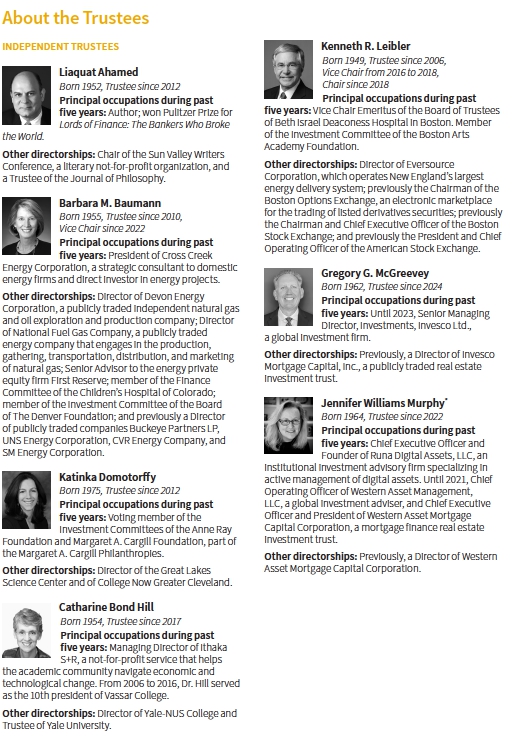
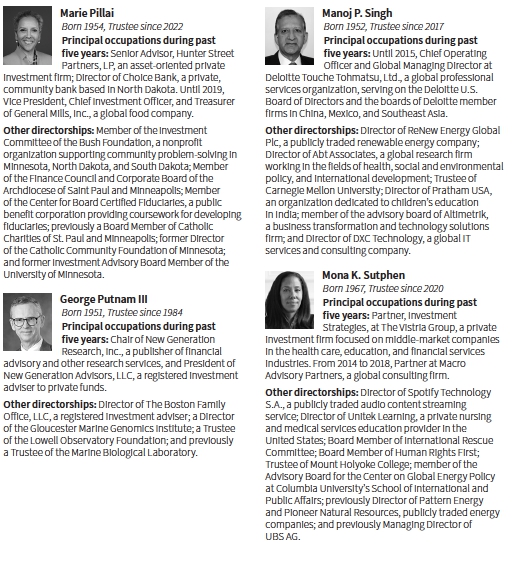
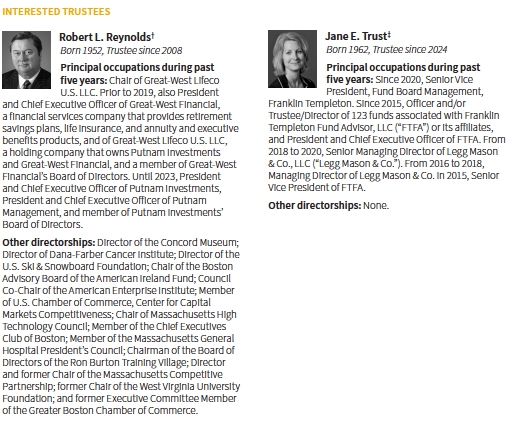
* Ms. Murphy is the founder, controlling member, and Chief Executive Officer of Runa Digital Assets, LLC (“RDA”), the investment manager of Runa Digital Partners, LP (“RDP”), a private investment fund. Ms. Murphy also holds a controlling interest in RDP’s general partner and is a limited partner in RDP. A subsidiary of Franklin Templeton and certain individuals employed by Franklin Templeton or its affiliates have made passive investments as limited partners in RDP (one of whom serves on the advisory board for RDA, which has no governance or oversight authority over RDA), representing in the aggregate approximately 33% of RDP as of October 31, 2023. In addition, if certain conditions are met, Franklin Templeton will be entitled to receive a portion of any incentive compensation allocable to RDP’s general partner. For so long as Franklin Templeton maintains its investment in RDP, Ms. Murphy also has agreed upon request to advise and consult with Franklin Templeton and its affiliates on the market for digital assets. Ms. Murphy provides similar service to other limited partners in RDP that request her advice. Ms. Murphy also is entitled to receive deferred cash compensation in connection with her prior employment by an affiliate of Franklin Templeton, which employment ended at the end of 2021. With regard to Ms. Murphy, the relationships described above may give rise to a potential conflict of interest with respect to the Funds.
† Mr. Reynolds is an “interested person” (as defined in the 1940 Act) of the fund and Putnam Management. He is President of your fund and each of the other Putnam funds and holds direct beneficial interest in shares of Franklin Templeton, of which Putnam Management is an indirect wholly-owned subsidiary.
‡ Ms. Trust is an “interested person” (as defined in the 1940 Act) of the fund and Putnam Management by virtue of her positions with certain affiliates of Putnam Management.
The address of each Trustee is 100 Federal Street, Boston, MA 02110.
As of April 30, 2024, the Putnam family of funds included 89 mutual funds, 4 closed-end funds, and 12 exchange-traded funds. Each Trustee serves as Trustee of all funds in the Putnam family of funds. Ms. Trust also serves as Trustee of 123 other funds that are advised by one or more affiliates of Putnam Management.
Each Trustee serves for an indefinite term, until his or her resignation, retirement at age 75, removal, or death.
Officers
In addition to Robert L. Reynolds, the other officers of the fund are shown below:
| |
| Kevin R. Blatchford (Born 1967) | Martin Lemaire (Born 1984) |
| Vice President and Assistant Treasurer | Vice President and Derivatives Risk Manager |
| Since 2023 | Since 2022 |
| Director, Financial Reporting, Putnam Holdings | Risk Manager and Risk Analyst, Putnam Management |
| |
| James F. Clark (Born 1974) | Denere P. Poulack (Born 1968) |
| Vice President and Chief Compliance Officer | Assistant Vice President, Assistant Clerk, |
| Since 2016 | and Assistant Treasurer |
| Chief Compliance Officer, Putnam Management | Since 2004 |
| and Putnam Holdings |
| Janet C. Smith (Born 1965) |
| Michael J. Higgins (Born 1976) | Vice President, Principal Financial Officer, Principal |
| Vice President, Treasurer, and Clerk | Accounting Officer, and Assistant Treasurer |
| Since 2010 | Since 2007 |
| | Head of Fund Administration Services, Putnam Holdings |
| Jonathan S. Horwitz (Born 1955) | and Putnam Management |
| Executive Vice President, Principal Executive Officer, | |
| and Compliance Liaison | Stephen J. Tate (Born 1974) |
| Since 2004 | Vice President and Chief Legal Officer |
| | Since 2021 |
| Kelley Hunt (Born 1984) | Deputy General Counsel, Franklin Templeton, and |
| AML Compliance Officer | Secretary, Putnam Holdings, Putnam Management, and |
| Since 2023 | Putnam Retail Management |
| Manager, U.S. Financial Crime Compliance, | |
| Franklin Templeton | |
The principal occupations of the officers for the past five years have been with the employers as shown above, although in some cases they have held different positions with such employers. The address of each officer, other than Ms. Hunt, is 100 Federal Street, Boston, MA 02110. Ms. Hunt’s address is 100 Fountain Parkway, St. Petersburg, FL 33716.
Fund information
| | |
| Investment Manager | Trustees | Michael J. Higgins |
| Putnam Investment | Kenneth R. Leibler, Chair | Vice President, Treasurer, |
| Management, LLC | Barbara M. Baumann, Vice Chair | and Clerk |
| 100 Federal Street | Liaquat Ahamed | |
| Boston, MA 02110 | Katinka Domotorffy | Jonathan S. Horwitz |
| | Catharine Bond Hill | Executive Vice President, |
| Investment Sub-Advisor | Gregory G. McGreevey | Principal Executive Officer, |
| Putnam Investments Limited | Jennifer Williams Murphy | and Compliance Liaison |
| Cannon Place, 78 Cannon Street | Marie Pillai | |
| London, England EC4N 6HL | George Putnam III | Kelley Hunt |
| | Robert L. Reynolds | AML Compliance Officer |
| Distribution Services | Manoj P. Singh | |
| Foreside Fund Services, LLC | Mona K. Sutphen | Martin Lemaire |
| Three Canal Plaza, Suite 100 | Jane E. Trust | Vice President and |
| Portland, ME 04101 | | Derivatives Risk Manager |
| | Officers | |
| Custodian | Robert L. Reynolds | Denere P. Poulack |
| State Street Bank | President, The Putnam Funds | Assistant Vice President, |
| and Trust Company | | Assistant Clerk, and |
| | Kevin R. Blatchford | Assistant Treasurer |
| Legal Counsel | Vice President and | |
| Ropes & Gray LLP | Assistant Treasurer | Janet C. Smith |
| | Vice President, |
| Independent Registered | James F. Clark | Principal Financial Officer, |
| Public Accounting Firm | Vice President and | Principal Accounting Officer, |
| PricewaterhouseCoopers LLP | Chief Compliance Officer | and AssistantTreasurer |
| | | |
| | | Stephen J. Tate |
| | | Vice President and |
| | | Chief Legal Officer |
Call 1-833-228-5577 (toll free) Monday through Friday between 9:00 a.m. and 5:00 p.m. Eastern Time or visit putnam.com or franklintempleton.com anytime for up-to-date information about the fund’s NAV.
|
| This page left blank intentionally. |
|
| This page left blank intentionally. |
| |
| a) The fund’s principal executive, financial and accounting officers are employees of Putnam Investment Management, LLC, the Fund’s investment manager. As such they are subject to a comprehensive Code of Ethics adopted and administered by Putnam Investments which is designed to protect the interests of the firm and its clients. The Fund has adopted a Code of Ethics which incorporates the Code of Ethics of Putnam Investments (Code of Ethics of Franklin Templeton effective March 4, 2024) with respect to all of its officers and Trustees who are employees of Putnam Investment Management, LLC. For this reason, the Fund has not adopted a separate code of ethics governing its principal executive, financial and accounting officers. |
| |
| (c) In connection with the acquisition of Putnam Investments by Franklin Templeton, the Putnam Investments Code of Ethics was amended effective January 1, 2024 to reflect revised compliance processes, including: (i) Compliance with the Putnam Investments Code of Ethics will be viewed as compliance with the Franklin Templeton Code for certain Putnam employees who are dual-hatted in Franklin Templeton advisory entities (ii) Certain Franklin Templeton employees are required to hold shares of Putnam mutual funds at Putnam Investor Services, Inc. and (iii) Certain provisions of the Putnam Investments Code of Ethics are amended that are no longer needed due to organizational changes. Effective March 4, 2024, the majority of legacy Putnam employees transitioned to Franklin Templeton policies outlined in the Franklin Templeton Code. |
| |
| Item 3. Audit Committee Financial Expert: |
| |
| The Funds’ Audit, Compliance and Risk Committee is comprised solely of Trustees who are “independent” (as such term has been defined by the Securities and Exchange Commission (“SEC”) in regulations implementing Section 407 of the Sarbanes-Oxley Act (the “Regulations”)). The Trustees believe that each member of the Audit, Compliance and Risk Committee also possesses a combination of knowledge and experience with respect to financial accounting matters, as well as other attributes, that qualifies him or her for service on the Committee. In addition, the Trustees have determined that each of Dr. Hill and Mr. Singh qualifies as an “audit committee financial expert” (as such term has been defined by the Regulations) based on their review of his or her pertinent experience and education.The SEC has stated, and the funds’ amended and restated agreement and Declaration of Trust provides, that the designation or identification of a person as an audit committee financial expert pursuant to this Item 3 of Form N-CSR does not impose on such person any duties, obligations or liability that are greater than the duties, obligations and liability imposed on such person as a member of the Audit, Compliance and Risk Committee and the Board of Trustees in the absence of such designation or identification. |
| |
| Item 4. Principal Accountant Fees and Services: |
| |
| The following table presents fees billed in each of the last two fiscal years for services rendered to the fund by the fund’s independent auditor: |
| | | | | |
| Fiscal year ended | Audit Fees | Audit-Related Fees | Tax Fees | All Other Fees |
|
|
| | | | | |
| April 30, 2024 | $21,021 | $ — | $3,293 | $ — |
| April 30, 2023 | $20,034 | $ — | $2,226 | $ — |
| |
| For the fiscal years ended April 30, 2024 and April 30, 2023, the fund’s independent auditor billed aggregate non-audit fees in the amounts of $667,656 and $244,237 respectively, to the fund, Putnam Management and any entity controlling, controlled by or under common control with Putnam Management that provides ongoing services to the fund. |
| |
| Audit Fees represent fees billed for the fund’s last two fiscal years relating to the audit and review of the financial statements included in annual reports and registration statements, and other services that are normally provided in connection with statutory and regulatory filings or engagements. |
| |
| Audit-Related Fees represent fees billed in the fund’s last two fiscal years for services traditionally performed by the fund’s auditor, including accounting consultation for proposed transactions or concerning financial accounting and reporting standards and other audit or attest services not required by statute or regulation. |
| |
| Tax Fees represent fees billed in the fund’s last two fiscal years for tax compliance, tax planning and tax advice services. Tax planning and tax advice services include assistance with tax audits, employee benefit plans and requests for rulings or technical advice from taxing authorities. |
| |
| Pre-Approval Policies of the Audit, Compliance and Risk Committee. The Audit, Compliance and Risk Committee of the Putnam funds has determined that, as a matter of policy, all work performed for the funds by the funds’ independent auditors will be pre-approved by the Committee itself and thus will generally not be subject to pre-approval procedures. |
| |
| The Audit, Compliance and Risk Committee also has adopted a policy to pre-approve the engagement by Putnam Management and certain of its affiliates of the funds’ independent auditors, even in circumstances where pre-approval is not required by applicable law. Any such requests by Putnam Management or certain of its affiliates are typically submitted in writing to the Committee and explain, among other things, the nature of the proposed engagement, the estimated fees, and why this work should be performed by that particular audit firm as opposed to another one. In reviewing such requests, the Committee considers, among other things, whether the provision of such services by the audit firm are compatible with the independence of the audit firm. |
| |
| The following table presents fees billed by the fund’s independent auditor for services required to be approved pursuant to paragraph (c)(7)(ii) of Rule 2–01 of Regulation S-X. |
| | | | | |
| Fiscal year ended | Audit-Related Fees | Tax Fees | All Other Fees | Total Non-Audit Fees |
|
|
| April 30, 2024 | $ — | $664,363 | $ — | $ — |
| April 30, 2023 | $ — | $242,011 | $ — | $ — |
| |
| Item 5. Audit Committee of Listed Registrants |
| |
| Item 6. Schedule of Investments: |
| |
| The registrant’s schedule of investments in unaffiliated issuers is included in the report to shareholders in Item 1 above. |
| |
| Item 7. Disclosure of Proxy Voting Policies and Procedures For Closed-End Management Investment Companies: |
| |
| Item 8. Portfolio Managers of Closed-End Investment Companies |
| |
| Item 9. Purchases of Equity Securities by Closed-End Management Investment Companies and Affiliated Purchasers: |
| |
| Item 10. Submission of Matters to a Vote of Security Holders: |
| |
| Item 11. Controls and Procedures: |
| |
| (a) The registrant’s principal executive officer and principal financial officer have concluded, based on their evaluation of the effectiveness of the design and operation of the registrant’s disclosure controls and procedures as of a date within 90 days of the filing date of this report, that the design and operation of such procedures are generally effective to provide reasonable assurance that information required to be disclosed by the registrant in this report is recorded, processed, summarized and reported within the time periods specified in the Commission’s rules and forms. |
| |
| (b) Changes in internal control over financial reporting: Not applicable |
| |
| Item 12. Disclosures of Securities Lending Activities for Closed-End Management Investment Companies: |
| |
| Item 13. Recovery of Erroneously Awarded Compensation. |
| |
| (a)(1) The Code of Ethics of The Putnam Funds, which incorporates the Code of Ethics of Putnam Investments, is filed herewith |
| |
| (a)(2) Any policy required by the listing standards adopted pursuant to Rule 10D-1 under the Exchange Act (17 CFR 240.10D-1) by the registered national securities exchange or registered national securities association upon which the registrant’s securities are listed. Not Applicable |
| |
| Pursuant to the requirements of the Securities Exchange Act of 1934 and the Investment Company Act of 1940, the registrant has duly caused this report to be signed on its behalf by the undersigned, thereunto duly authorized. |
| |
| By (Signature and Title): |
| |
| /s/ Janet C. Smith
Janet C. Smith
Principal Accounting Officer
|
| |
| Pursuant to the requirements of the Securities Exchange Act of 1934 and the Investment Company Act of 1940, this report has been signed below by the following persons on behalf of the registrant and in the capacities and on the dates indicated. |
| |
| By (Signature and Title): |
| |
| /s/ Jonathan S. Horwitz
Jonathan S. Horwitz
Principal Executive Officer
|
| |
| By (Signature and Title): |
| |
| /s/ Janet C. Smith
Janet C. Smith
Principal Financial Officer
|

